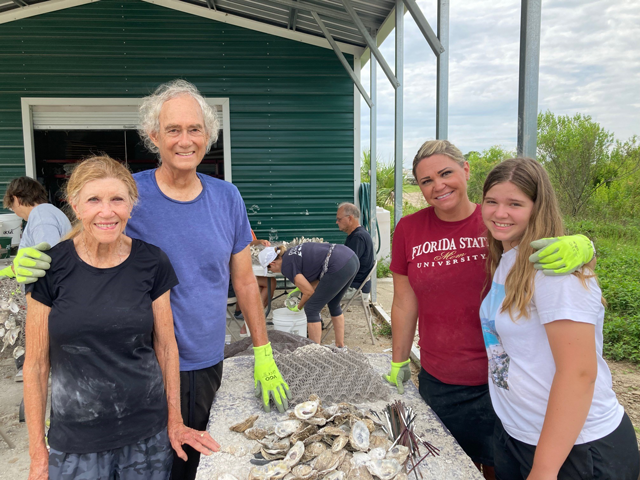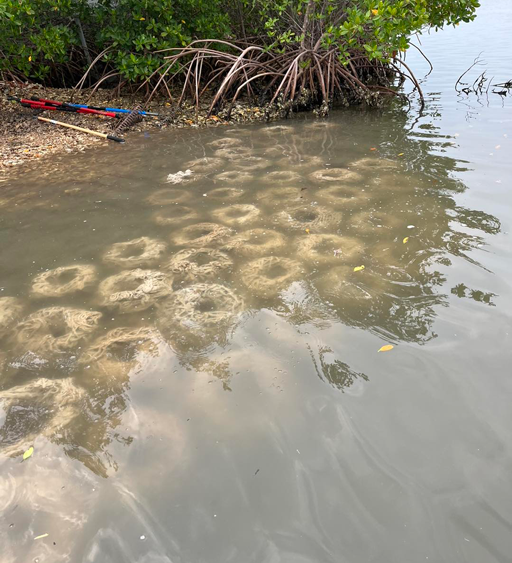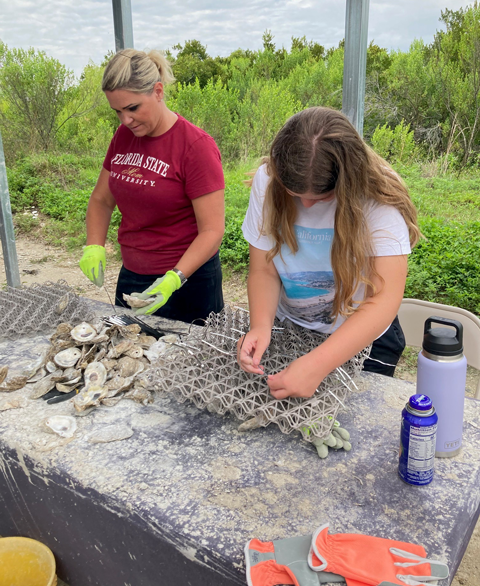By Lisa D. Mickey
At Marine Discovery Center, they are affectionately called “the Volcano family.” And for good reason.
That’s because the pursuit of a family activity at MDC turned into a family passion to create the non-plastic material utilized by MDC’s conservation team for shoreline stabilization in the Indian River Lagoon.
“My daughter Carrie was looking for a volunteer activity for our granddaughter Mia,” said Pat Flanders, a retired geologist who spent 32 years working for the Army Corps of Engineers in exploration and construction. “She went to a volcano workshop at MDC and told us about it, so we wanted to try it, too, and we just got hooked because it’s so much fun.”
Pat, husband Mike Flanders, their daughter Carrie Miller and granddaughter Mia Miller didn’t just show up and dabble. They dove in to make about 500 volcanoes in 16 workshops. They also raised the bar for other MDC volunteers, constructing a record 55 volcanoes in three hours.
“They love a good challenge, which leads to things like setting records,” said Tess Sailor-Tynes, MDC’s Conservation Science Coordinator. “They are a fun-loving family who is focused on the quality of our restoration work, while also understanding the importance of creating community within these workshops.”
Volunteers who help construct the volcanoes start by cutting large rolls of jute erosion-control blankets into scraps, which are then saturated with water and a mixture of pH-balanced cement. The module is then formed by hand, using a mold that looks like a volcano, which takes about 20 minutes to set.
When the finished volcanoes are deployed into a shoreline that is being restored, they are placed in a staggered line to buffer wake energy from continuously pounding the shoreline. That buffer helps protect the native plants, such as cord grass or mangrove trees, used in the shoreline restoration.
It’s messy work and on a hot day, volunteers gather outdoors at MDC under a sheltered area in front of a giant fan to place their hands on products that will ultimately find their way into waters of the lagoon. The goal is restoration, conservation and ultimately, cleaner water for the estuarine ecosystem.
“It’s more fun to get dirty,” said Mike, a musician and pastor, who lives in Deland with wife Pat.
“It’s just fun and I care about helping the manatees by making the water cleaner,” said Mia, 14, of New Smyrna Beach.
The family has worked to make not only volcanoes, but they have also helped construct BESE mats – another shoreline stability element – as well as to work with MDC’s conservation team to remove Brazilian pepper. In addition, they have drilled holes in the oyster shells used to make the BESE mats.
“They have been a reliable and hard-working group that MDC’s conservation team counts on,” added Julia Petersen, conservation specialist at MDC. “Since starting this volunteer work, they’ve gotten really passionate about conservation and restoration with MDC. It’s awesome to watch a family come together every week to spend time together doing meaningful work.”
Carrie noted that her family enjoys fishing and paddle boarding in the lagoon and her interest was sparked when she first saw the volcanoes in the water.
“I didn’t know what they were,” said Carrie, a production manager and prop maker for a California film company. “We got started in this when I saw information online about a volcano workshop and went to learn about them.”
Carrie was curious about the volcanoes, but she also wanted her daughter to gain volunteer experience in diverse activities.
“Mia is part of the community where we live and I want her to volunteer her time because it matters,” Carrie added. “This is teaching her stewardship, plus it’s fun to be hands-on with things and we can also see the benefits in the waters where we play.”
On a recent Saturday, the four family members and three maternal generations were focused on making BESE mats alongside other MDC volunteers. It wasn’t the most traditional family-bonding experience, but it was obvious it was an enjoyable task for each of them as they conversed with other volunteers and each other.
“It’s great for families and is a very unique activity,” said Mike. “I’ve certainly never done this before, so we’re in a very special club.”
“It means so much just to spend this time together,” added Pat. “I used to also work in hazardous and toxic waste projects with the geologic exploration and construction we did, so this means something to me. Water quality matters here and it should matter everywhere.”
Work on the BESE mats ended in June and work on the volcanoes will resume in the fall. The family plans to continue working with MDC’s conservation team to make volcanoes and BESE mats as soon as they can return.
“We don’t want to take the summer off!” said Mike enthusiastically. “We want to keep working.”
And for Mia, she hopes to continue to enhance her knowledge about the lagoon she enjoys so much.
“I’ve actually learned more about rivers and lagoons and why this is important,” she said. “If the ecosystem crashes and there’s nothing the earth can use to provide for itself, doing these things gives us a chance to help the environment and to help the creatures that live here.”
And you can bet when it’s time to restart MDC’s building activities for volunteers later this year, the “Volcano family” will be right there with their hands in the mess, loving every sticky minute of their time together.





Follow Us!